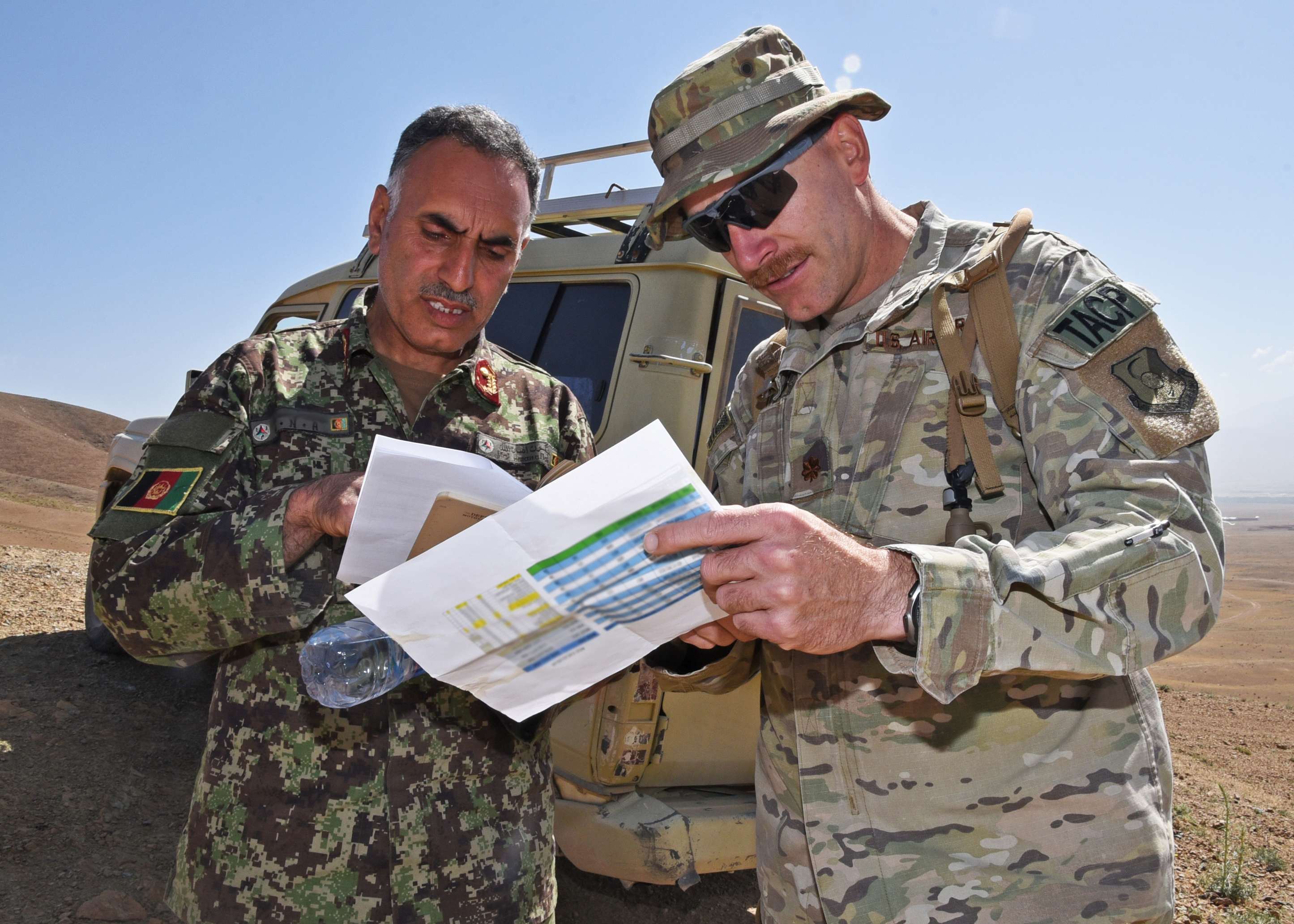
Maj. Chris Larson, one of Train, Advise, Assist Command-Air (TAAC-Air) air-to-ground integration lead advisors, coordinates information with his Afghan Air Force counterpart before a live-fire training exercise for a class of Afghan Tactical Air Coordinators near Logar Province, Afghanistan, May 21, 2017. US Air Force photo by TSgt. Veronica Pierce.
Before the Defense Department can elevate the profile of its air advisory role in Afghanistan, it needs to find airmen with advising experience—a capability currently easier said than done.
Top military leadership, therefore, has tasked Air Education and Training Command to get better at identifying and developing airmen with foreign advising experience.
“It’s a priority not only from [Defense Secretary Jim Mattis], but also from the Chief of Staff of the Air Force [Gen. David Goldfein] that we build this capacity and we deliberately expose airmen to it,” AETC commander Lt. Gen. Darryl Roberson told Air Force Magazine.
On Oct. 3, in announcing the new Afghanistan strategy for the military, Mattis said US advisors will now locate themselves “at the battalion and brigade level”—an important change because “those units with NATO and American advisors win, and those without them often do not win,” he noted. As a result, “We’re going to spread [out] the number of units with advisors.”
To help accomplish this mission, AETC has launched a new “developmental special experience” (DSE) initiative, and one of its is helping commanders to more easily identify an airman experienced in a specific capability and utilize that knowledge.
While AETC is still working with Air Force Headquarters on the “delineation between policy and execution” in regards to the initiative, first USAF must create an IT system capable of integrating all the necessary data into one platform.
“We’re in good position to have that accomplished by early Spring of next year,” Roberson said. Such a system will let USAF “have visibility and be able to coordinate in a way that we’re currently not able to do,” he said, adding that then work can begin “in earnest,”
In Search of Experience
The Air Force requires “many airmen” to serve as air advisors, where they help train other countries on how to improve or develop capabilities for their air forces, but it doesn’t “give them credit in a meaningful way for that experience,” Roberson said.
For example, he explained, C-130 operators, loadmasters, or aircrew that become air advisors, whether it’s for a few months or a few years, can be very helpful in developing coalition capabilities. Creating and tracking these assignments that fall outside of an airman’s specialty will eventually mean “any commander, or any person that needs to find somebody who has this experience, will be able to access this learning record,” Roberson said.
Efforts to identify what current experiences should constitute as DSEs, and concurrently what DSEs should be created, are “just beginning,” Roberson said. The “several year process” will ultimately result in a “continually developing roster,” aimed at two critical improvements: increasing airmen’s exposure to the joint environment and to the cross domain warfighting environment—two of Goldfein’s key focus areas.
Some DSE-worthy exposures—like air advising—”already exist,” Roberson said. “We just have to put it on a list and actually credential them.” That process is one of three tasks within the work ahead for AETC.
The second is identifying where to search for potential DSEs. For example, a DSE focused on joint environment exposure already is in the works with the Army. The Army’s III Corps will soon begin a two-week exercise to identify they’re ready to be a Joint Task Force headquarters, ahead of deploying downrange “within the year,” Roberson said. So AETC wants to throw an airman into that exercise, someone to learn how the Army works this sort of deployment.
“I’ve already talked to the Army and they’ve agreed to the concept,” he said. “During their two-week exercise, we have a DSE of, let’s say, a young captain, to go in and sit right next to the Army planner … and just learn how they do it, be a part of that team.”
Including Industry
Finally, AETC will put out feelers for DSEs within industry, academia, and other non-military partners.
“We’re already thinking about how we can build a DSE with Silicon Valley,” Roberson said. “We’re behind the curve a little bit with our ability to do coding in-house, inside the United States Air Force.”
From data engineers to artificial intelligence specialists, Roberson envisions DSEs for airmen to learn how “to take big data and turn it into something usable for a commander in a much more quick timeframe,” for example.
In the end, Roberson wants airmen who are exposed to a “more broad fighting environment” early in their career, rather than toward its end, as is sometimes the case now. That way, when they get to a certain level in their career—whether it’s a “senior NCO [noncommissioned officer] or a senior officer”—they can “thrive and lead in that environment.”
And with that: “We want to make all airmen more broadly capable at the op?erational level of air, space, and cyberspace than they are today,” he added.